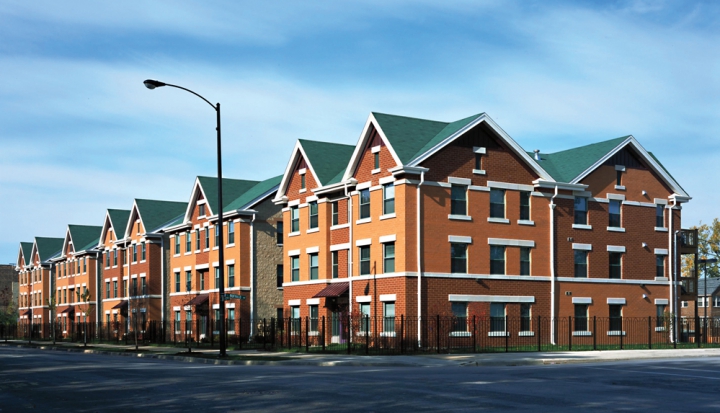Life for most children takes place within a six block radius of their home: school, shopping, worship, and play. These six blocks help define who they are, what they do, and what they can become. If this six-block radius changes every few months, what are the odds of that child gaining stability and sense of worth?
The majority of people would consider shelter, food, and clothing basic needs. Housing is critical as one of the most foundational requirements to live a healthy and productive life. Whether that shelter is a condo, a teepee, an igloo, or the Taj Majal, what one calls home adds to the shape of how children see themselves now and what they can envision for their future.
According to the 2010 Census almost 51 percent of Chicago renters and 49 percent of Chicago homeowners are cost burdened, a term used to describe paying more than 30 percent of one’s income toward housing. Many of these families spend up to 60 percent of their income trying to keep a roof over their families’ heads while also trying to decide how they will use the remaining portion to cover the rest of their needs.
With foreclosure rates still recovering from record highs, the challenge of housing instability touches 57 of the 77 communities that make up Chicago, making it the 37th most expensive city in the United States, according to the National Housing Conference. This often exacerbates other issues plaguing these neighborhoods such as increasing crime rates, under- and unemployment, lack of education, and many others. In fact, more than 200,000 residents left Chicago between 2000 and 2010, the majority of which were family households, according to Chicago Rehab Network.
Statistics from the National Housing Conferences’ Paycheck to Paycheck database show that the 2017 Fair Market Rent (FMR) for a two-bedroom unit in Chicago is $1,232 and would require a person working 40 hours a week and earn a minimum of $22 per hour to afford it. With current minimum wage at $11 per hour in Chicago, it would take at least 84 hours per week to afford this unit.
It might be easy to dismiss this scenario and encourage people to go out and get better jobs; however, looking at the issue from a different perspective, the average office clerk makes a little over $18 per hour and would have to work 51 hours to afford the unit, while bank tellers and janitors average an income of about $14 per hour and would need to work 66 hours. Even a Chicago firefighter, who on average earns about $23 per hour, barely makes enough to afford a two-bedroom home. What if he has more than two children or his children are unable to share a room? City of Chicago hiring policies mandate that city workers reside within the city limits, but can they afford to live in the city?
My perspective on the issue comes from having been born in the midst of my father’s deployment during the Vietnam War. My mother and I lived with my maternal grandmother in anticipation of his return. Around 5 years old, after we had reunited, I remember living in what seemed like a huge multi-unit building across the street from where I attended kindergarten. The apartment had lots of windows, and I have a faint but fond memory of my dad (after having been up all night Christmas Eve assembling a play kitchen set for me) rushing off to a shift as a Chicago Transit Authority bus driver.
Shortly after that Christmas my parents used a Veteran Administration (VA) loan to purchase a two-unit building a few blocks away. Although it was literally less than two miles away, I recognize now that this decision changed the dynamic of my life. Our new neighborhood and the stability of being homeowners exposed us to many opportunities that we might not have experienced otherwise and kept my life from being as nomadic as some others have experienced.
This move enabled me to attend the same elementary, middle, and eventually high school with most of the same kids from the neighborhood and enjoy the stability of calling a place home. The summer before my 13th birthday, we moved exactly two blocks to a single family home that my parents still live in more than three decades later. This stability helped me focus on my goals and dreams while being exposed to a variety of choices.
Housing is a fundamental point of growth in any other area, such as employment, education, and social networks. I realize that the stability of my home and my six blocks helped me to dream big. My parents’ ability to use their resources to provide stability for my sister and me opened up opportunities and relationships that I cherish to this day. It’s also the reason that my husband and I have chosen to do the same with our son. We both have college degrees, and we have chosen to make our six blocks in a neighborhood where this is not the reality for the majority of our fellow neighbors.
While our neighborhood experiences high levels of unemployment, foreclosure, crime, violence, and housing instability, it is also full of families who just want to provide more for the next generation. Serving in a nonprofit where I live, I see children every day who not only worry about getting to school and back safely within their six blocks but also if they will be able to eat again after they leave school. They wonder constantly about what is in store for them if they do graduate.
Claretian Associates has focused on providing housing as a way to assist with other areas, but housing must be first. Some of the children we serve come from homes where they have moved more times in a few years than others have their entire life. The instability of their housing has caused them to rotate from place to place. They come from homes where parents are working hard and finding it more and more difficult to make ends meet and deciding between food, clothing, and shelter or having to double up or do without in order to survive.
Where there is housing first attention can be given to other goals. It is not housing only, just housing first. Housing instability is not just an issue for poor families but 50 percent of all families in the Chicago metro area, according to the Chicago Rehab Network.
These are our teachers, food prep workers, and even firefighters who can’t affordably live in the city they serve. These are challenging issues that will need to be addressed or a greater number of families will continue to struggle with the basic need of housing.
Each of us lives within some six-block radius and possesses the ability to make sure that there are options and housing stability for families of all sizes. We can become educated about the issues and support public representatives and legislation that promote affordable housing or support organizations like Claretian Associates (claretianassociates.org); we can spread the word that housing first matters. Unless we get the basics right, we’ll continue to see families who never truly belong to any particular six blocks.
This article also appears in the February 2018 issue of U.S. Catholic (Vol. 83, No. 2, pages 23–24).
Image: Courtesy of Claretian Associates













Add comment